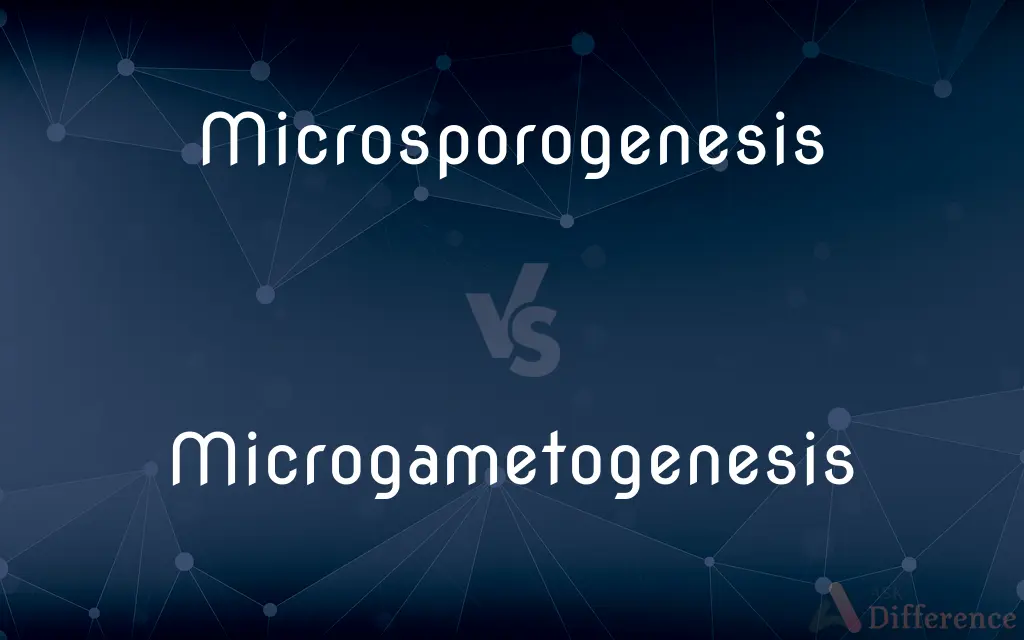Microsporogenesis vs. Microgametogenesis — What's the Difference?
Edited by Tayyaba Rehman — By Fiza Rafique — Updated on September 27, 2023
Microsporogenesis is the formation of microspores inside pollen sacs of seed plants, while Microgametogenesis refers to the development of these microspores into male gametophytes or pollen grains.

Difference Between Microsporogenesis and Microgametogenesis
Table of Contents
ADVERTISEMENT
Key Differences
Microsporogenesis and Microgametogenesis are crucial processes in the life cycle of flowering plants, ensuring the generation and development of male gametophytes. Microsporogenesis is an earlier step, wherein diploid cells within the pollen sacs undergo meiosis to produce haploid microspores. Microgametogenesis follows, converting these microspores into functional pollen grains, which will carry the male gametes.
In Microsporogenesis, the primary focus is on the formation of microspores. This process occurs within the anthers of flowering plants and is a result of meiotic division. On the other hand, Microgametogenesis is concerned with the maturation of these microspores, where they develop structures that help in the fertilization process.
During Microsporogenesis, each cell that undergoes meiosis produces four haploid microspores. In contrast, in Microgametogenesis, each of these microspores will typically give rise to a pollen grain containing sperm cells ready for fertilization.
While Microsporogenesis is purely about formation, Microgametogenesis is about development and maturation. This means after the microspores are formed through Microsporogenesis, they undergo a series of changes, enabled by Microgametogenesis, to become fully mature pollen grains, capable of fertilizing an ovule.
Comparison Chart
Definition
Formation of microspores
Development of microspores into male gametophytes
ADVERTISEMENT
Stage
Precedes Microgametogenesis
Follows Microsporogenesis
Result
Haploid microspores
Mature pollen grains
Process
Meiotic division
Developmental changes
Function
Production of microspores
Ensures microspores are ready for fertilization
Compare with Definitions
Microsporogenesis
The genesis of small spores in plants.
Without microsporogenesis, the plant would not produce viable pollen grains.
Microgametogenesis
The post-meiotic phase in male gametophyte development.
Microgametogenesis involves multiple cellular changes to produce a functional pollen grain.
Microsporogenesis
The initial step in pollen grain formation.
Microsporogenesis sets the stage for the next steps in male gamete production.
Microgametogenesis
A maturation process in the male reproductive cycle of plants.
The pollen tube formation during microgametogenesis helps deliver sperm cells to the ovule.
Microsporogenesis
The process by which microspores are formed in plants.
During microsporogenesis, the diploid cell undergoes meiosis to produce four haploid microspores.
Microgametogenesis
The development of microspores into pollen grains.
Following microsporogenesis, microgametogenesis ensures the pollen grains are ready for fertilization.
Microsporogenesis
A division process in the anthers of flowering plants.
The anther contains cells that are essential for microsporogenesis.
Microgametogenesis
The transformation of haploid spores into male gametes.
It's during microgametogenesis that sperm cells within the pollen grain are formed.
Microsporogenesis
A meiotic event in seed plants.
Microsporogenesis ensures genetic variation in offspring by producing haploid spores.
Microgametogenesis
Ensures the readiness of pollen for fertilization events.
The success of fertilization in plants often depends on the proper completion of microgametogenesis.
Microsporogenesis
The formation of microspores.
Microgametogenesis
Microgametogenesis is the process in plant reproduction where a microgametophyte develops in a pollen grain to the three-celled stage of its development. In flowering plants it occurs with a microspore mother cell inside the anther of the plant.
Microsporogenesis
(botany) The formation of four haploid microspores by meiosis.
Microgametogenesis
(botany) The gametogenesis of microgametes
Microsporogenesis
(botany) In angiosperms, the formation of pollen and thus the production of the male gametophyte.
Common Curiosities
Where does Microsporogenesis occur in plants?
Microsporogenesis occurs within the anthers of flowering plants.
What is the end product of Microgametogenesis?
The end product of microgametogenesis is a mature pollen grain ready for fertilization.
Are both Microsporogenesis and Microgametogenesis exclusive to male reproductive parts of plants?
Yes, both processes are related to the development and maturation of male gametophytes in plants.
Is Microsporogenesis a mitotic or meiotic process?
Microsporogenesis involves a meiotic division.
What's the significance of Microgametogenesis in plant reproduction?
Microgametogenesis ensures the production of functional pollen grains, which are crucial for fertilization in plants.
What is the primary product of Microsporogenesis?
The primary product of microsporogenesis is haploid microspores.
What follows after Microsporogenesis in the life cycle of plants?
After microsporogenesis, microgametogenesis takes place, leading to the development of mature pollen grains.
What happens to microspores after Microsporogenesis?
After microsporogenesis, microspores undergo microgametogenesis to develop into mature pollen grains.
Is Microgametogenesis a single-step process?
No, microgametogenesis involves multiple developmental stages to transform a microspore into a pollen grain.
Can a plant produce pollen without Microsporogenesis?
No, microsporogenesis is the essential first step in producing pollen grains.
Share Your Discovery

Previous Comparison
Statue vs. Status
Next Comparison
Scant vs. ScantyAuthor Spotlight
Written by
Fiza RafiqueFiza Rafique is a skilled content writer at AskDifference.com, where she meticulously refines and enhances written pieces. Drawing from her vast editorial expertise, Fiza ensures clarity, accuracy, and precision in every article. Passionate about language, she continually seeks to elevate the quality of content for readers worldwide.
Edited by
Tayyaba RehmanTayyaba Rehman is a distinguished writer, currently serving as a primary contributor to askdifference.com. As a researcher in semantics and etymology, Tayyaba's passion for the complexity of languages and their distinctions has found a perfect home on the platform. Tayyaba delves into the intricacies of language, distinguishing between commonly confused words and phrases, thereby providing clarity for readers worldwide.
















































